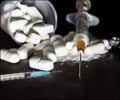A new definition of addiction highlighting that addiction is a chronic brain disorder and not simply a behavioral problem involving too much alcohol, drugs, gambling or sex has been released

When people see compulsive and damaging behaviors in friends or family members—or public figures such as celebrities or politicians—they often focus only on the substance use or behaviors as the problem. However, these outward behaviors are actually manifestations of an underlying disease that involves various areas of the brain, according to the new definition by ASAM, the nation's largest professional society of physicians dedicated to treating and preventing addiction.
"At its core, addiction isn't just a social problem or a moral problem or a criminal problem. It's a brain problem whose behaviors manifest in all these other areas," said Dr. Michael Miller, past president of ASAM who oversaw the development of the new definition. "Many behaviors driven by addiction are real problems and sometimes criminal acts. But the disease is about brains, not drugs. It's about underlying neurology, not outward actions."
The new definition resulted from an intensive, four-year process with more than 80 experts actively working on it, including top addiction authorities, addiction medicine clinicians and leading neuroscience researchers from across the country. The full governing board of ASAM and chapter presidents from many states took part, and there was extensive dialogue with the National Institute on Drug Abuse (NIDA).
The new definition also describes addiction as a primary disease, meaning that it's not the result of other causes such as emotional or psychiatric problems. Addiction is also recognized as a chronic disease, like cardiovascular disease or diabetes, so it must be treated, managed and monitored over a life-time.
Two decades of advancements in neurosciences convinced ASAM that addiction needed to be redefined by what's going on in the brain. Research shows that the disease of addiction affects neurotransmission and interactions within reward circuitry of the brain, leading to addictive behaviors that supplant healthy behaviors, while memories of previous experiences with food, sex, alcohol and other drugs trigger craving and renewal of addictive behaviors. Meanwhile, brain circuitry that governs impulse control and judgment is also altered in this disease, resulting in the dysfunctional pursuit of rewards such as alcohol and other drugs. This area of the brain is still developing during teen-age years, which may be why early exposure to alcohol and drugs is related to greater likelihood of addiction later in life.
Advertisements
"Choice still plays an important role in getting help. While the neurobiology of choice may not be fully understood, a person with addiction must make choices for a healthier life in order to enter treatment and recovery. Because there is no pill which alone can cure addiction, choosing recovery over unhealthy behaviors is necessary," Hajela said.
Advertisements
Source-Eurekalert











